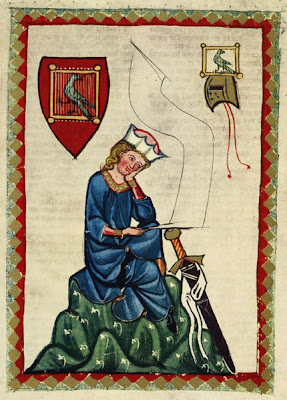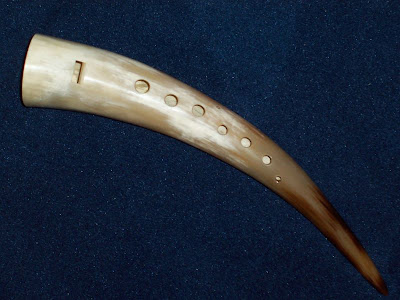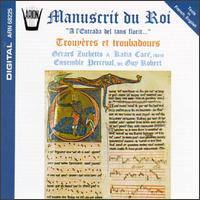 Waltehr von der Vogelweide (Minnesinger) - Palestinalied
Waltehr von der Vogelweide (Minnesinger) - Palestinalied
Walther von der Vogelweide (c. 1170 - c. 1230) is the most celebrated of the Middle High German lyric poets.
For all his fame, Walther's name is not found in contemporary records, with the exception of a solitary mention in the travelling accounts of Bishop Wolfger of Erla of the Passau diocese.."Walthero cantori de Vogelweide pro pellicio v solidos longos"--"To Walther the singer of the Vogelweide five shilling for a fur coat." and the main sources of information about him are his own poems and occasional references by contemporary Minnesingers. It is also clear from the title hêr (Herr, Sir) these give him, that he was of noble birth; but it is equally clear from his name Vogelweide (= "bird pasture", Latin aviarium, a place where birds were caught) that he didn't belong to the higher nobility, who took their titles from castles or villages, but to the nobility of service (Dienstadel), humble retainers of the great lords, who in wealth and position were wide distant from non-noble free cultivators.
Walther’s birthplace is still unknown today and it will probably never be possible to indicate it exactly because of a lack of written documents. There is little chance to derive it from his name. In mediaeval times there were many so-called “Vogelweiden” in the vicinity of castles and towns where hawks were caught for hawking or songbirds for people's homes. For this reason it must be assumed that the singer did not obtain his name primarily for superregional communication, because it could not be used for an unambiguous assignment. (Other persons of the high nobility and poets who used to travel with their masters used the unambiguous name of their ownership or their place of origin). Therefore the name was meaningful only in the near vicinity, where only one Vogelweide existed or it was understood as a metaphoric surname of the singer. (Stage-names were usual for poets of the 12th and 13th century, whereas minnesingers in principle were known by their noble family name which was used to sign documents.)
In 1974 Helmut Hörner identified a farmhouse mentioned in 1556 as “Vogelweidhof” in the urbarium of the domain Rappottenstein. At this time it belonged to the Amt Traunstein, now within the municipality Schönbach (Lower Austrian Waldviertel = forest quarter. Its existence had already mentioned without comment in 1911 by Alois Plesser, who also did not know its precise location. Hörner proved that the still existing farmhouse Weid is indeed the mentioned Vogelweidhof and collected arguments for Walther being born in the Waldviertel. He published this in his 1974 book 800 Jahre Traunstein (800 years Traunstein), pointing out that Walter says “Ze ôsterriche lernt ich singen unde sagen” ("In Austria [at this times only Lower Austria and Vienna], I learned to sing and to speak"). A tradition says that Walther, one of the ten Old Masters was a Landherr (land owner) from Bohemia, which does not contradict his possible origin in the Waldviertel, because in mediaeval times the Waldviertel was from time to time denoted as versus boemiam. Powerful support for this theory was given in 1977 and 1981 by Bernd Thum (University Karlsruhe, Germany) which makes an origin in the Waldviertel very plausible. Thum began with an analysis of the content of Walther’s work, especially of his crusade appeal, also known as “old age elegy” and concluded that Walther’s birthplace was far away from all travelling routes of this time and within a region where still land was cleared. This is because the singer pours out his sorrows “Bereitet ist daz velt, verhouwen ist der walt” and suggests he no longer knows his people and land, applicable to the Waldviertel.
Additionally in 1987 Walter Klomfar and the librarian Charlotte Ziegler came to the conclusion that Walther might have been born in the Waldviertel. The starting point for their study is also the above mentioned words of Walther. These were placed into doubt by research but strictly speaking do not mention his birthplace. Klomfar points to a historical map which was drawn by monks of the Zwettl monastery in the 17th century, on the occasion of a legal dispute. This map shows a village Walthers and a field marked “Vogelwaidt” and a related house belonging to the village. The village became deserted, but a well marked on the map could be excavated and reconstructed to prove the accuracy of the map. Klomfar was also able to partly reconstruct land ownership in this region and prove the existence of the (not rare) Christian name Walther.
Contrary to this theory, Franz Pfeiffer assumed that the singer was born in the Wipptal in South Tyrol, where, not far from the small town of Sterzing on the Eisack, a wood - called the Vorder- and Hintervogelweide -exists. This would, however, contradict the fact that Walther was not able to visit his homeland for many decades. At this time Tyrol was the home of several well-known Minnesingers. The court of Vienna, under Duke Frederick I of the house of Babenberg, had become a centre of poetry and art.
Here it was that the young poet learned his craft under the renowned master Reinmar the Old, whose death he afterwards lamented in two of his most beautiful lyrics; and in the open handed duke he found his first patron. This happy period of his life, during which he produced the most charming and spontaneous of his love-lyrics, came to an end with the death of Duke Frederick in 1198. Henceforward Walther was a wanderer from court to court, singing for his lodging and his bread, and ever hoping that some patron would arise to save him from this "juggler's life" (gougel-fuore) and the shame of ever playing the guest. For material success in this profession he was hardly calculated. His criticism of men and manners was scathing; and even when this did not touch his princely patrons, their underlings often took measures to rid themselves of so uncomfortable a censor.
Thus he was forced to leave the court of the generous duke Bernhard of Carinthia (1202-1256); after an experience of the tumultuous household of the landgrave of Thuringia he warns those who have weak ears to give it a wide berth; and after three years at the court of Dietrich I of Meissen (reigned 1195-1221) he complains that he had received for his services neither money nor praise.
Generosity could be mentioned by Walther von der Vogelweide. He received a diamond from the high noble Diether III von Katzenelnbogen around 1214.
Walther was, in fact, a man of strong views; and it is this which gives him his main significance in history, as distinguished from his place in literature. From the moment when the death of the emperor Henry VI (1197) opened the fateful struggle between empire and papacy, Walther threw himself ardently into the fray on the side of German independence and unity. Though his religious poems sufficiently prove the sincerity of his Catholicism, he remained to the end of his days opposed to the extreme claims of the popes, whom he attacks with a bitterness which can only be justified by the strength of his patriotic feelings. His political poems begin with an appeal to Germany, written in 1198 at Vienna, against the disruptive ambitions of the princes: "Crown Philip with the Kaiser's crown And bid them vex thy peace no more."
He was present, on September 8, at Philip's coronation at Mainz, and supported him till his victory was assured. After Philip's murder in 1209, he "said and sang" in support of Otto of Brunswick against the papal candidate Frederick of Hohenstaufen; and only when Otto's usefulness to Germany had been shattered by the Battle of Bouvines (1212) did he turn to the rising star of Frederick II, now the sole representative of German majesty against pope and princes.
From the new emperor his genius and his zeal for the empire at last received recognition; and a small fief in Franconia was bestowed upon him, which, though he complained that its value was little, gave him the home and the fixed position he had so long desired. That Frederick gave him an even more signal mark of his favour by making him the tutor of his son Henry (VII), King of the Romans, is more than doubtful. The fact, in itself highly improbable, rests only upon the evidence of a single poem, which can also be interpreted otherwise. Walther's restless spirit did not suffer him to remain long on his new property.
In 1217 he was once more at Vienna, and again in 1219 after the return of Duke Leopold VI from the crusade. About 1224 he seems to have settled on his fief near Würzburg. He was active in urging the German princes to take part in the crusade of 1228, and may have accompanied the crusading army at least as far as his native Tirol. In a beautiful and pathetic poem he paints the change that had come over the scenes of his childhood and made his life seem a thing dreamed. He died about 1230, and was buried at Würzburg, after leaving directions, according to the story, that the birds were to be fed at his tomb daily. The original gravestone with its Latin inscription has disappeared; but in 1843 a new monument was erected over the spot, called Lusamgärtchen (Lusam garden), today cornered in between the two major churches of the city. There is also a statue of the poet at Bolzano, unveiled in 1877.
Historically interesting as Walther's political verses are, their merit has been not a little exaggerated by many 19th and early 20th century German critics, who saw their own imperial aspirations and anti-papal prejudices reflected in this patriotic poet of the Middle Ages. Usually considered to be of more lasting value are his lyrics, mainly dealing with love, which led his contemporaries to hail him as their master in song (unsers sanges meister). He is of course uneven. At his worst he does not rise above the tiresome conventionalities of his school. At his best he shows a spontaneity, a charm and a facility which his rivals sought in vain to emulate. His earlier lyrics are full of the joy of life, of feeling for nature and of the glory of love. Greatly daring, he even rescues love from the convention which had made it the prerogative of the nobly born, contrasts the titles "woman" (wip) and "lady" (frouwe) to the disadvantage of the latter, and puts the most beautiful of his lyrics—Under der linden—into the mouth of a simple girl. A certain seriousness, which is apparent under the joyousness of his earlier work, grew on him with years. Religious and didactic poems become more frequent; and his verses in praise of love turn at times to a protest against the laxer standards of an age demoralized by political unrest. Throughout his attitude is regarded as healthy and sane. He preaches the crusade; but at the same time he suggests the virtue of toleration, pointing out that in the worship of God, "Christians, Jews and heathen all agree."
He fulminates against "false love"; but pours scorn on those who maintain that "love is sin." In an age of monastic ideals and loose morality there was nothing commonplace in the simple lines in which he sums up the inspiring principle of chivalry at its best: "Swer guotes wibes liebe hat Der schamt sich ieder missetat."
Altogether Walther's poems give us the picture not only of a great artistic genius, but of a strenuous, passionate, very human and very lovable character.
Hannover Medieval Market Mansion Gardens - Palestinalied (2009)
Annwn (1990) - Palestinalied
Qntal (1991) - Palestinalied (2004)
In Extremo (1995) - Palestina Lied (2005)
Torture (1997) - Palestinaliedes (2006)
***
Minnesang was the tradition of lyric and song writing in Germany which flourished in the 12th century and continued into the 14th century. People who wrote and performed Minnesang are known as Minnesingers (Minnesänger). The name derives from the word minne, Middle High German for love which was their main subject, and an individual song was a minnelied. The Minnesänger were similar to the Provençal troubadours and northern French trouvères; they wrote love poetry in the courtly love tradition in Middle High German in the High Middle Ages.
In the absence of reliable biographical information, there has been debate about the social status of the Minnesänger. Some clearly belonged to the higher nobility - the 14th century Codex Manesse includes songs by dukes, counts, kings, and the Emperor Henry VI. Some Minnesänger, as indicated by the title Meister ("master"), were clearly educated commoners, such as Meister Konrad von Würzburg. It is thought that many were ministeriales, that is, members of a class of lower nobility, vassals of the great lords. Broadly speaking, the Minnesänger were writing and performing for their own social class at court, and should be thought of as courtiers rather than "professional" hired musicians. Friedrich von Husen, for example, was part of the entourage of Friedrich Barbarossa, and died on crusade. As a reward for his service, Walther von der Vogelweide was given a fief by the Emperor Frederick II.
Several of the best known Minnesingers are also noted for their epic poetry, among them Henric van Veldeke, Wolfram von Eschenbach and Hartmann von Aue.
The earliest texts date from perhaps 1150, and the earliest named Minnesänger are Der von Kürenberg and Dietmar von Aist, clearly writing in a native German tradition in the third quarter of the 12th century. This is referred to as the Danubian tradition.
From around 1170, German lyric poets came under the influence of the Provençal troubadours and the Northern French trouvères. This is most obvious in the adoption of the strophic form of the canzone, at its most basic a seven-line strophe with the rhyme scheme ab|ab|cxc, and a musical AAB structure, but capable of many variations.
A number of songs from this period match trouvère originals exactly in form, indicating that the German text could have been sung to an originally French tune, which is especially likely where there are significant commonalities of content. Such songs are termed contrafacta. For example, Friedrich von Hausen's "Ich denke underwilen" is regarded as a contrafactum of Guiot de Provins's "Ma joie premeraine".
By around 1190, the German poets began to break free of Franco-Provençal influence. This period is regarded as the period of Classical Minnesang with Albrecht von Johansdorf, Heinrich von Morungen, Reinmar von Hagenau developing new themes and forms, reaching its culmination in Walther von der Vogelweide, regarded both in the Middle Ages and in the present day as the greatest of the Minnesänger.
The later Minnesang, from around 1230, is marked by a partial turning away from the refined ethos of classical minnesang and by increasingly elaborate formal developments. The most notable of these later Minnesänger, Neidhart von Reuental introduces characters from lower social classes and often aims for humorous effects.
Only a small number of Minnelied melodies have survived to the present day, mainly in manuscripts dating from the 15th century or later, which may present the songs in a form other than the original one. Additionally, it is often rather difficult to interpret the musical notation used to write them down. Although the contour of the melody can usually be made out, the rhythm of the song is frequently hard to fathom.
In the 15th century Minnesang developed into and gave way to the tradition of the Meistersingers. The two traditions are quite different, however (Minnesingers were mainly aristocrats, while Meistersingers were merchants, for example).
At least two operas have been written about the Minnesang tradition: Richard Wagner's Tannhäuser and Richard Strauss' Guntram.
Selected Notable Minnesänger
Classical Minnesang
Walter von der Vogelweide
Wolfram von Eschenbach
Later Minnesang: 13th Century
Neidhart von Reuental (1st half of the 13th Century)
Der Tannhäuser [!]
Ulrich von Liechtenstein (ca. 1200-1275)
Walther von Klingen (1240-1286)
[8108 Neidhart / 8170 Walther / 8170 Tassin]



























